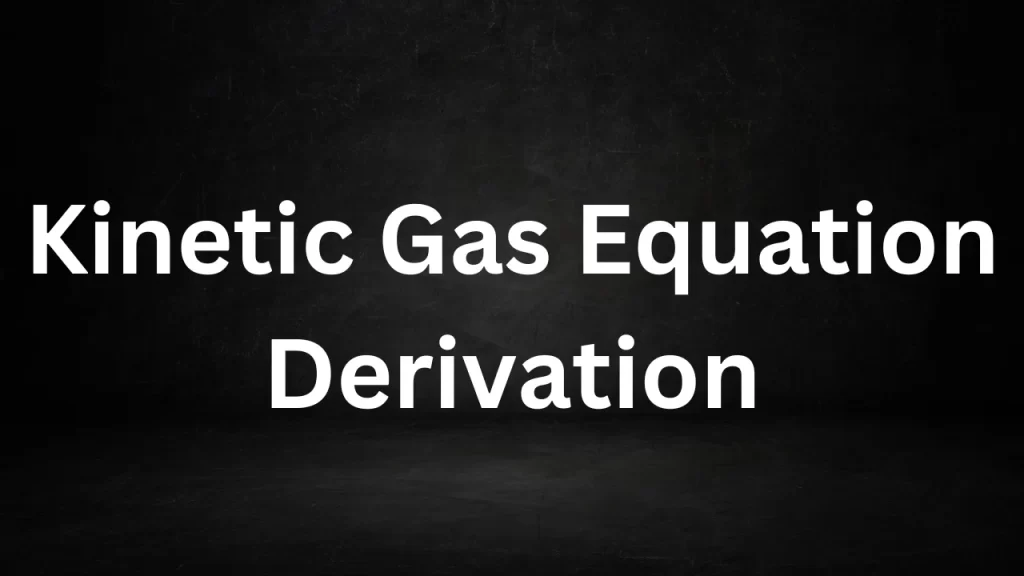Kinetic Gas Equation Derivation: The kinetic gas equation, also known as the ideal gas law, describes the behavior of an ideal gas under various conditions.
It relates the pressure, volume, and temperature of a gas to the number of gas molecules and the ideal gas constant. Here, we’ll outline the derivation of the kinetic gas equation step by step.

Kinetic Gas Equation Derivation
Step 1: Understanding Assumptions
The ideal gas law is based on several assumptions:
- Gas molecules are considered to be point masses with no volume.
- Gas molecules undergo elastic collisions with each other and the container walls.
- There are no intermolecular forces between gas molecules.
- The volume occupied by the gas molecules themselves is negligible compared to the container’s volume.
Step 2: Defining Pressure and Force
Pressure (P) is defined as force (F) per unit area (A):
P = F/A
Step 3: Force Due to Collisions
Consider a gas molecule colliding with a container wall. The change in momentum during the collision generates a force on the wall. The average force is given by Newton’s second law as:
Where:
- ∆m is the change in momentum of the molecule,
- v_x is the x-component of the velocity of the molecule, and
- ∆t is the time between successive collisions.
Step 4: Relating Force to Pressure
Substituting the force expression into the pressure definition gives:
Step 5: Relating Velocity and Temperature
The average kinetic energy of a gas molecule is proportional to its temperature (T) in Kelvin: 3/2= 1/2
Where:
- k is the Boltzmann constant,
- m is the mass of a gas molecule,
- v is the root-mean-square velocity of the molecules.
Step 6: Substituting Velocity into Pressure Expression
Substitute the expression for velocity (v) from the kinetic energy equation into the pressure equation:
Step 7: Molecule Count
The number of molecules per unit volume (n/V) is defined as the number density: Where N is the total number of molecules in the volume V.
Step 8: Combining Equations
Substitute the expression for the number density into the pressure equation:
Step 9: Introducing Ideal Gas Constant
The ideal gas constant (R) is defined as:
Step 10: Arriving at the Kinetic Gas Equation
Substitute the ideal gas constant into the equation:
This equation simplifies to:
Since 2 is the average kinetic energy ( = 3/2):
This is the kinetic gas equation, also known as the ideal gas law:
Where:
- P is pressure,
- V is volume,
- n is the number of moles of gas,
- R is the ideal gas constant,
- T is temperature.
The kinetic gas equation describes the behavior of ideal gases under various conditions, providing insights into their macroscopic properties based on the motion of their constituent particles.
Read More
- Electromagnetic Waves Transverse Nature Class 10
- Difference Between KVA And KW
- Difference Between LCD And LED
- Electric Potential of a Point Charge Class 10
- Difference Between In Physics
Frequently Asked Question (FEQs)
What is the kinetic gas equation, also known as the ideal gas law?
The kinetic gas equation, often referred to as the ideal gas law, is a fundamental equation in thermodynamics that describes the relationship between the pressure (P), volume (V), temperature (T), and amount of gas (n) in a system. It is represented by the equation PV = nRT, where R is the ideal gas constant.
Why is the ideal gas law also called the kinetic gas equation?
The ideal gas law is sometimes called the kinetic gas equation because it is derived based on the kinetic theory of gases, which considers the motion of gas molecules and their collisions.
What are the assumptions made in the derivation of the kinetic gas equation?
The derivation of the kinetic gas equation is based on the following assumptions:
- Gas molecules are considered to be point masses with no volume.
- Gas molecules undergo perfectly elastic collisions with each other and the container walls.
- There are no intermolecular forces between gas molecules.
- The volume occupied by the gas molecules is negligible compared to the container’s volume.
How does the kinetic gas equation relate pressure, volume, temperature, and the number of gas molecules?
The kinetic gas equation, PV = nRT, establishes a direct relationship between the pressure, volume, temperature, and number of moles of gas in a system. It implies that for a given amount of gas, an increase in temperature or volume results in a proportional increase in pressure.
What role does the ideal gas constant (R) play in the equation?
The ideal gas constant (R) is a proportionality constant that relates the physical properties of a gas to the equation. It provides a bridge between the microscopic behavior of gas molecules and the macroscopic properties described by pressure, volume, temperature, and amount of gas.
